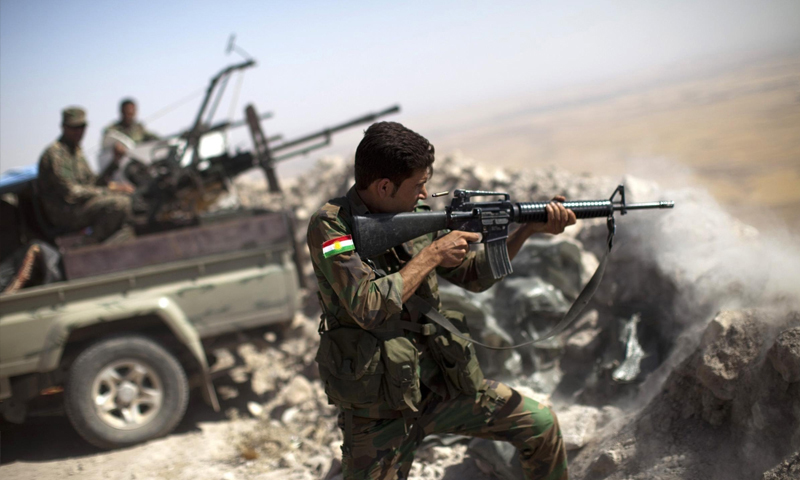Clashes between the Turkish-backed Syrian National Army (SNA) and the Syrian Democratic Forces (SDF) supported by the Russian-backed Syrian regime forces continue over the M4 international highway and the strategically-located towns of Tel Tamer and Ain Issa even as Turkey and Russia stressed that the Sochi agreement signed on 22 October is still in effect.
The ongoing conflict in these two areas raises the question of their importance and why the warring sides insist on expanding their areas of control. In a recent report Enab Baladi investigated the importance of Tel Tamer in al-Hasakah countryside.
Ain Issa: capital of the Autonomous Administration of North and East Syria (NES)
Ain Issa is a Syrian nahiyah (subdistrict) located in Tel Abyad district in the province of Raqqa. Ain Issa is a key node in the transportation network that connects the provinces of Aleppo and al-Hasakah through the M4 highway. The town has an important network of local roads linking it to the city of Tel Abyad on the Turkish border, and the city of Raqqa.

Field map showing military control in the rural areas of al-Hasakah and Raqqa, north-east Syria – 18 November 2019 (edited by Enab Baladi)
Ain Issa was taken over by the SDF with the support of the Global Coalition, in mid-2015, after a long conflict with the so-called Islamic State, which failed in several attempts to regain it.
The US troops, leading the Global Coalition, established a military base in Ain Issa in early 2016. This raised the profile of Ain Issa, prompting the Kurdish NES to establish a large number of its institutions and councils therein.
A Kurdish journalist working for a local media newspaper, who spoke to Enab Baladi on condition of anonymity on 1 December, saidthat Ain Issa had become a semi-capital of the Autonomous Administration of North at the instigation of the US. He also pointed out that Ain Issa had been neglected, and its social services had been very poor before the establishment of the US military base.
Several important meetings between NES officials, Global Coalition officials and Western officials were held in Ain Issa, according to the journalist.
According to Enab Baladi, about two months ago a delegation of the British Parliament visited Ain Issa and met with the joint heads of the executive and general boards and several members of the NES.
The visit of the British delegation to Ain Issa coincided with the visit of the representative of the French Foreign Ministry, Eric Chevallier, accompanied by a German delegation.
William Roebuck, Deputy Special Envoy to the Global Coalition and Senior Advisor to the Special Representative for Syria Engagement, held a meeting with leaders of the NES last July in Ain Issa.
In addition to the visits made by Global Coalition officials to Ain Issa, regular meetings of the NES institutions—interior body, health authority, women’s council, and executive councils—were held monthly in Ain Issa.
Moreover, “Tribal Forum” was held in Ain Issa; all the tribal elders and dignitaries from the north-eastern Syria met with the leaders and deputies of the joint presidency of the NES Executive Council, such as Abd Hamid al-Mahbash, Perivan Khalid, Elisabeth Korea, Amina Osei, and refugee camp responsible in northern and eastern Syria, Shikhmus Ahmad.
According to the NES-affiliated news agency ANHA, the Tribal Forum resulted in the return of women and children, who had been displaced to al-Houl camp during the conflict with ISIS, to their homes in northern and eastern areas of Syria.
Ain Issa, the front line in the defense of Ayn al-Arab
Fighting continues in the eastern region of the Euphrates in spite of the Russian-Turkish agreement of 22 October.The agreement provided for the cessation of fighting in the eastern region of the Euphrates under several terms.
The SNA spokesperson, Yousef Hamoud, told Enab Baladi on Sunday,1 December that the SDF is holding onto Ain Issa because it is considered the first and main line of defense for the city of Ayn al-Arab in the countryside of Aleppo.
Hamoud said that Ain Issa is located on an important road network and is a transportation node that connects the areas of Ayn al-Arab and Tel Abyad with Manbij. Hamoud stressed that in case the SDF loses its control over Ain Issa, they will be faced with a loss of communication with Ayn Arab.
Syrian regime forces entered Ain Issa a day after the agreement signed with the NES on 13 October. The agreement stated that the Syrian regime forces will be deployed in the NES-held areas to prevent the advance of the Turkish army, which had begun its military operation on 9 October.
In early November, Russian military trucks and armored vehicles loaded with arms and ammunition arrived in the town of Ain Issa.
North Press Agency, specialized in publishing the news of the north-east regions in Syria, posted photos of Russian trucks and armored vehicles as they headed to the center of military operations and coordination between Russian forces and the SDF in the town.
Russia is backing the SDF to stay in Ain Issa. Hamoud believes that “Russia does not want the SDF to get out of Ain Issa because Russia is exerting pressure on other actors in the region through the SDF.”
There have been mutual accusations between Turkey and the NES of violating the Russian-Turkish agreement.
Ankara insists on removing the Kurdish People’s Protection Units (YPG)— the backbone of the SDF— and establishing the so-called safe zone area between the cities of Tel Abyad and Ras al-Ayn.
Turkey and the SNA gained control over these cities during the Operation Peace Spring.











